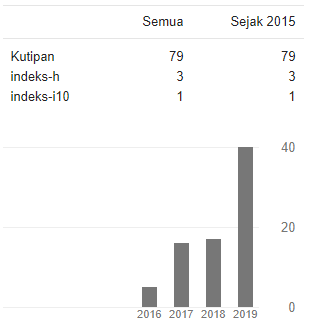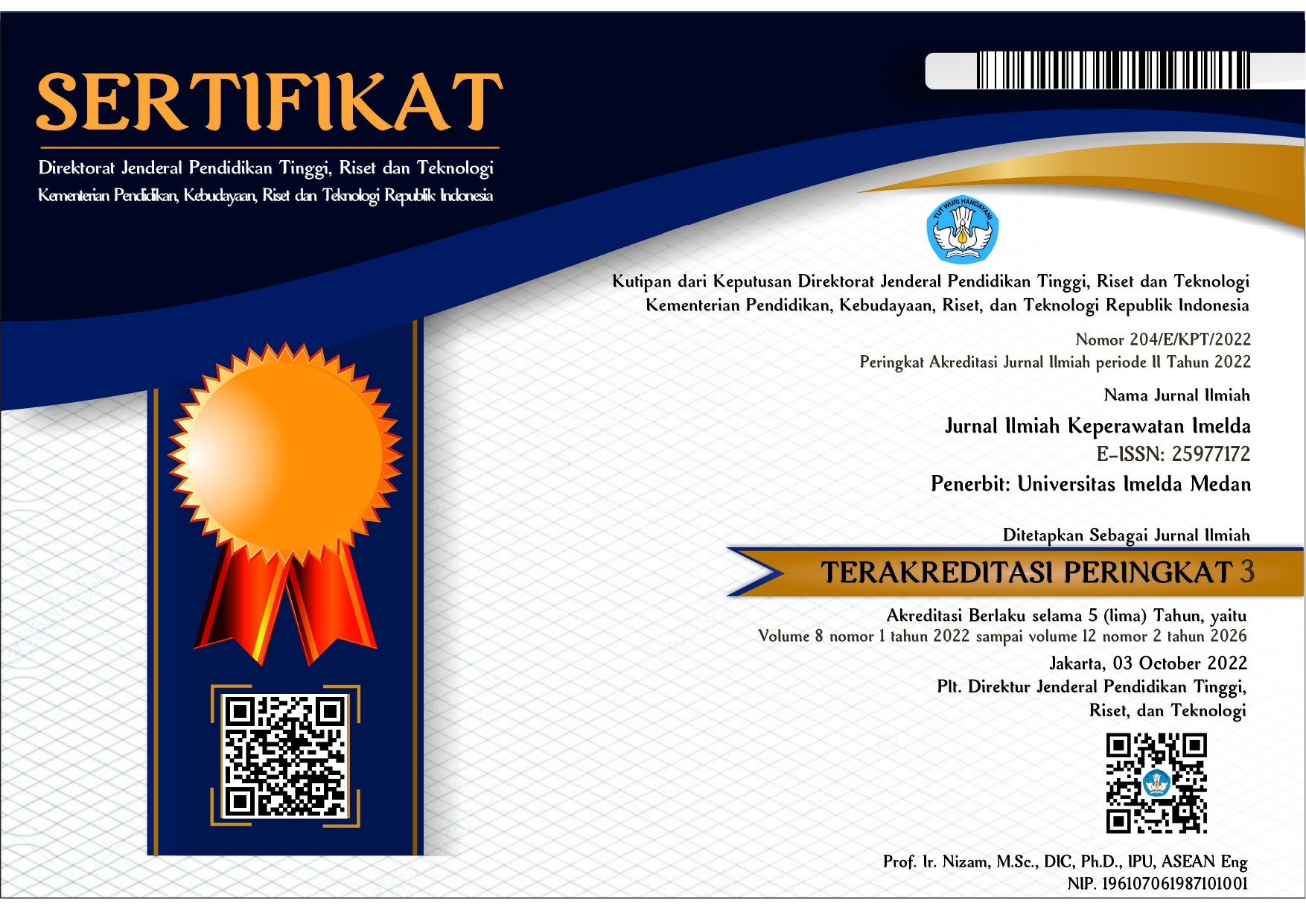GAMBARAN KONSUMSI MINUMAN MANIS, MAKAN GORENGAN, DEPRESI DAN AKTIVITAS FISIK PADA OBESITAS USIA DEWASA
DOI:
https://doi.org/10.52943/jikeperawatan.v8i2.1082Keywords:
Sweet drink consumption, fried eating, depression, physical activity, obesityAbstract
Background: Based on the results of Riskesdas in 2018, it can be seen that the prevalence of the adult population (>18 years) with overweight (BMI ? 25) is 8.9%. The prevalence of overweight and obesity in adults in East Java was 22.4%. The regency/city that has the highest prevalence of obesity nutritional status in East Java is Mojokerto City which is 44.18% and the Regency/City that has the lowest prevalence of obesity nutritional status is Sumenep Regency which is 18.23%. This study aims to determine the picture of the distribution and frequency of consumption of sugary drinks, eating fried foods, depression and physical activity in adult obesity in East Java based on secondary data from Riskesdas in 2018. Method: The design of this study uses descriptive quantitative research with a Secondary Data Analysis approach. Results: Consumption of sugary drinks, fried food consumption and depression are not related to one nutritional obesity in adolescence in East Java, while physical activity is related to the incidence of obesity nutritional status in adulthood in East Java. Conclusion: there is an increase in the proportion of nutritional status of obesity in adulthood which is closely related to physical activity. Less physical activity will result in fat accumulation because there is no burning process, which in the end the accumulation of fat makes a person obese. However, based on the results of cross-tabulation, there was no relationship between sweet consumption habits, fried eating habits, and depression with the proportion of obesity nutritional status in adulthood.
Keywords: Sweet drink consumption, fried eating, depression, physical activity, obesity
Downloads
References
Carbone, S., Lavie, C., & Arena, R. (2017). Obesity and Heart Failure: Focus on the Obesity Paradox.
Fatmala, T., & Rohmah, M. (2022). Hubungan Konsumsi Minuman Berpemanis Dengan Obesitas Pada Remaja. Nusantara Hasana Journal, 2(1), 220–255.
Fatmawati, I. (2019). Asupan gula sederhana sebagai faktor risiko obesitas pada siswa-siswi sekolah menengah pertama di Kecamatan Pamulang, Kota Tangerang Selatan. Ilmu Gizi Indonesia, 2(2), 147–154.
Hafid, W., & Hanafi, S. (2019). Hubungan Aktivitas Fisik dan Konsumsi Fast Food dengan Kejadian Obesitas Pada Remaja. Kampurui Jurnal Kesehatan Masyarakat (The Journal of Public Health), 1(1), 6–10.https://doi.org/10.55340/kjkm.v1i1.49
Kementerian Kesehatan RI. (2007). Hasil Riset Kesehatan Dasar Tahun 2007. Kementerian Kesehatan RI.
Kementerian Kesehatan RI. (2013). Hasil Riset Kesehatan Dasar Tahun 2013. Kementerian Kesehatan RI.
Kementerian Kesehatan RI. (2018a). Hasil Riset Kesehatan Dasar Provinsi Jawa Timur Tahun 2018. Kementerian Kesehatan RI.
Kementerian Kesehatan RI. (2018b). Hasil Riset Kesehatan Dasar Tahun 2018. Kementerian Kesehatan RI.
Khoiriyah Parinduri, F., Djokosujono, K., & Khodijah Parinduri, S. (2021). Faktor Dominan Obesitas Sentral Pada Usia 40-60 Tahun Di Indonesia (Analisis Data Indonesian Family Life Survey 5 Tahun 2014/2015). Hearty, 9(2), 58. https://doi.org/10.32832/hearty.v9i2.5397
Lilly, L. (2016). Pathophysiology of Heart Disease. Wolters KluweR.
Murtane, N. M. (2021). Obesitas dan Depresi pada Orang Dewasa. Jurnal Ilmiah Kesehatan Sandi Husada, 10(1), 88–93. https://doi.org/10.35816/jiskh.v10i1.515
Nurmadinisia, R., Achmad, E. K., Kusharisupeni, K., & Utari, D. M. (2020). Faktor Dominan Kejadian Obesitas pada Pegawai Negeri Sipil di Kementerian Agama Pusat Tahun 2018. Jurnal Ilmu Kesehatan Masyarakat, 9(02), 72–84. https://doi.org/10.33221/jikm.v9i02.497
Praditasari, J., & Sumarmik, S. (2018). Asupan Lemak, Aktivitas Fisik dan Kegemukan pada Remaja Putri di SMP Bina Insani Surabaya. Media Gizi Indonesia, 13(2), 117–122.
Qoirinasari, Q., Simanjuntak, B., & Kusdalinah, K. (2018). Berkontribusikah konsumsi minuman manis terhadap berat badan berlebih pada remaja? AcTion: Aceh Nutrition Journal, 3(2), 88–94.
Rahman, F. A., Roekmantara, T., & Romadhona, N. (2022). Pengaruh Obesitas terhadap Kejadian Penyakit Jantung Koroner (PJK) pada Populasi Dewasa. BandungConference Series: Medical Science , 2(1), 1002–1008. https://proceedings.unisba.ac.id/index.php/BCSMS/article/view/1979
Ronna Fiskasari, S., Isti Angraini, D., & Yusran, M. (2020). Hubungan Depresi, Ansietas dan Stres dengan Status Gizi pada Mahasiswa Fakultas Kedokteran Universitas Lampung. Mahasiswa Fakultas Kedokteran Universitas Lampung Medula |, 10, 572–580.
Sugiatmi, S., & Handayani, D. R. (2018). Faktor Dominan Obesitas pada Siswa Sekolah Menengah Atas di Tangerang Selatan Indonesia. Jurnal Kedokteran Dan Kesehatan, 14(1), 1. https://doi.org/10.24853/jkk.14.1.1-10
Telisa, I., Hartati, Y., & Haripamilu, A. D. (2020). Faktor Risiko Terjadinya Obesitas Pada Remaja SMA Risk Factors of Obesity among Adolescents in Senior High School. Faletehan Health Journal, 7(3), 124–131.
World Health Organization. (2019). Obesity. In https://www.who.int/topics/obesity/en/









